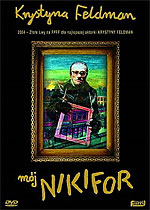 I’m reviewing Krzysztof Krauze’s My Nikifor (Mój Nikifor, 2004) in much more detail for Sight & Sound, but here’s a précis: a quiet, understated, rather moving film about an elderly tramp (or so he initially seems) who installs himself in the studio of artist Marian Włosiński (Roman Gancarczyk) and produces tiny paintings on card at a furious rate. Włosiński’s boss Nowak (Jerzy Gudejko), a cultural functionary, recognises him as the naïve painter Nikifor and insists that he stay, as the government has a policy of promoting folk, or peasant, art. And as Nikifor stays, Włosiński gradually realises that he has a natural talent that his academy training can never hope to match.
I’m reviewing Krzysztof Krauze’s My Nikifor (Mój Nikifor, 2004) in much more detail for Sight & Sound, but here’s a précis: a quiet, understated, rather moving film about an elderly tramp (or so he initially seems) who installs himself in the studio of artist Marian Włosiński (Roman Gancarczyk) and produces tiny paintings on card at a furious rate. Włosiński’s boss Nowak (Jerzy Gudejko), a cultural functionary, recognises him as the naïve painter Nikifor and insists that he stay, as the government has a policy of promoting folk, or peasant, art. And as Nikifor stays, Włosiński gradually realises that he has a natural talent that his academy training can never hope to match.
In more melodramatic hands, this could have turned into an Amadeus remake, with Włosiński in the jealous Salieri role, but in fact director Krzysztof Krauze and his screenwriter wife Joanna Kos stick strictly to the known facts, which are that Włosiński more or less gave up his career to look after Nikifor and ensure he had a decent working environment – no mean feat when one considers that Nikifor is both verbally and physically unsavoury, even to the point of posing a health risk for Włosiński and his family.
I watched it twice, the first time with literally no advance knowledge (I didn’t even know that Nikifor was played by a woman, the veteran actress Krystyna Feldman, who does a remarkable job), the second time after doing some background research into Nikifor’s real-life career, and enjoyed it much more as a result. I suspect Krauze’s Polish target audience would have been similarly well-informed, as Nikifor seems to be as famous there as the Douanier Rousseau (a close equivalent) is in France.